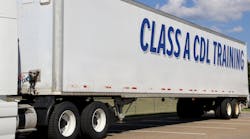There’s always room for improvement when it comes to managing your driver training programs. How you train your drivers and what comes after is a good place to start.
A comprehensive driver training program is essential in helping trucking companies keep their drivers and assets safe and keep freight moving. Classroom, online, hands-on/practical, and video forms of training, are all effective methods to teach drivers. Fleets with the best safety practices use a combination of these forms of training to teach the information and skills drivers need to know to keep themselves and others they share the roads with safe.
But even if your fleet already has a robust training program, there is likely more that you can do to further maximize the effectiveness of your fleet safety program. We get asked all the time about what more fleets can do to supplement what they’re teaching drivers through training programs. Our answer is this: find opportunities to engage with drivers after they complete training to keep the subject “top of mind.” Follow-up activities, incentives, surveys, and driver communication strategies (social media) are all things fleets can utilize post-training to support drivers.
Many top-performing fleets in the industry are already doing this. Through our evaluations of fleets each year through the Best Fleets to Drive For program, we’ve noticed that many of the finalists in the program use a combination of these follow-up strategies to help drivers better comprehend and retain training information.
See also: TCA, CarriersEdge name 2023 Best Fleets to Drive For
For concepts, particularly those that are taught online or in class, it’s beneficial to have some sort of “active” follow-up activity or series of activities for drivers to demonstrate what they’ve learned. For example, if a driver completed training on truck and trailer weight and dimensions through an online course, activities that could be beneficial to follow up with may be to practice approaching a weigh scale at the terminal with the correct speed and steering. They could also practice preparing or naming the correct documentation requirements. It's one thing to pass a written or online test, showing that you comprehend the information that was taught. It’s another to take that information and apply it in a real-world situation.
Incentives, surveys, social media promotions, and other communication strategies can help keep important safety topics at the forefront for longer periods of time. Incentives can be especially useful in aiming to prevent or correct a behavioral issue, such as distracted driving.
There are a variety of ways to use post-training engagements with drivers to support their education and safe driving practices. But it’s important to not do too many at once so you don’t overwhelm your drivers. Start small with follow-up activities that cover a specific subject and see how it goes. Depending on the subject you may find that a couple of activities are all that are needed to help drivers better understand a particular training concept, others may require more ongoing engagements. If there are opportunities for executives to participate in engagements with drivers, they should be involved. Recording a video of the president of the company practicing a driving skill like backing into a loading dock is an idea. Or better yet, have them participate in a live activity with drivers. It helps build morale and shows that everyone plays a role in being committed to fleet safety.
By continuing to engage with drivers after they complete training on safety-related topics, you can help build better safety or driving habits and improve the overall driving learning experience.
Jane Jazrawy is CEO of CarriersEdge, a provider of online driver training for the trucking industry, and co-creator of Best Fleets to Drive For, an annual evaluation of the best workplaces in the North American trucking industry produced in partnership with Truckload Carriers Association.



